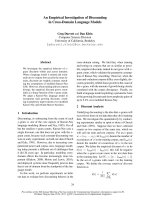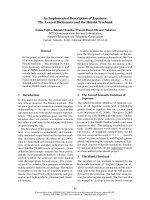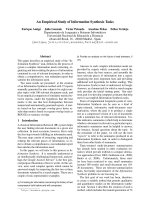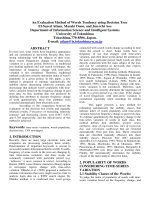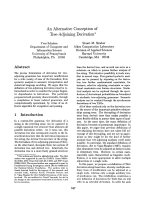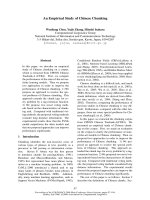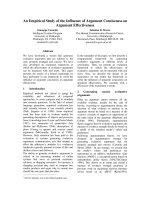Báo cáo khoa học: "An Attribute-Grammar Implementation of Government-bindlng Theory" docx
Bạn đang xem bản rút gọn của tài liệu. Xem và tải ngay bản đầy đủ của tài liệu tại đây (483.21 KB, 7 trang )
An Attribute-Grammar Implementation of Government-bindlng Theory
Nelson
Correa
Department of Electrical and Computer Engineering
Syracuse University
111 Link Hall
Syracuse, NY 13244
ABSTRACT
The syntactic analysis of languages with respect to
Government-binding (GB) grammar is a problem
that has received relatively little attention until
recently. This paper describes an attribute grammar
specification of the Government-binding theory. The
paper focuses on the description of the attribution
rules responsible for determining antecedent-trace
relations in phrase-structure trees, and on some
theoretical implications of those rules for the GB
model. The specification relies on a
transformation-lem variant of Government-binding
theory, briefly discussed by Chomsky (1981), in
which the rule move-a is replaced by an interpretive
rule. Here the interpretive rule is specified by means
of attribution rules. The attribute grammar is
currently being used to write an English parser
which embodies the principles of GB theory. The
parsing strategy and attribute evaluation scheme
are cursorily described at the end of the paper.
Introduction
In this paper we consider the use of attribute gram-
mars (Knuth, 1968; Waite and Goos, 1984) to pro-
vide a computational definition of the Government-
binding theory layed out by Chomsky (1981, 1982).
This research thus constitutes a move in the direc-
tion of seeking specific mechanisms and realizations
of universal grammar. The attribute grammar pro-
vides a specification at a level intermediate between
the abstract principles of GB theory and the partic-
ular automatons that may be used for parsing or
generation of the language described by the theory.
Almost by necessity and the nature of the goal set
out, there will be several arbitrary decisions and
details of realization that are not dictated by any
particular linguistic or psychological facts, but
perhaps only by matters of style and possible com-
putational efficiency considerations in the final pro-
duct. It is therefore safe to assume that the partic-
ular attribute grammar that will be arrived at
admits of a large number of non-isomorphic vari-
ants, none of which is to be preferred over the oth-
ers a priori. The specification given here is for
English. Similar specifications of the parametrized
grammars of typologically different languages may
eventually lead to substantive generalizations about
the computational mechanisms employed in natural
languages.
The purpose of this research is twofold: First,
to provide a precise computational definition of
Government-binding theory, as its core ideas are
generally understood. We thus begin to provide an
answer to criticisms that have recently been leveled
against the theory regarding its lack of formal expli-
citness (Gazdar et aI., 1985; PuUum, 1985). Unlike
earlier computational models of GB theory, such as
that of Berwick and Weinberg (1984), which
assumes Marcus' (1980) parsing automaton, the
attribute grammar specification is more abstract
and neutral regarding the choice of parsing'auto-
mata. Attribute grammar offers a language
specification frsxnework whose formal properties are
generally well-understood and explored. A second
and more important purpose of the present research
is to provide an alternate and mechanistic charac-
terization of the principles of universal grammar.
To the extent that the implementation is correct,
the principles may be shown to follow from the sys-
tem of attributes in the grammar and the attribu-
tion rules that define their values.
The current version of the attribute grammar
is presently being used to implement an English
parser written in Prolog. Although the parser is not
yet complete, we expect that its breath of coverage
of the language will be substantially larger than
that of other Government-binding parsers recently
reported in the literature (Kashket (1986), Kuhns
(1986), Sharp (1985), and Wehrli (1984)). Since the
parser is firmly based on Government-binding
theory, we expect its ability to handle natural
language phenomena to be limited only by the accu-
racy and correctness of the underlying theory.
In the development below I will assume that
the reader is familiar with the basic concepts and
terminology of Government-binding theory, as well
as with attribute grammars. The reader is referred
to Sells (1985) for a good introduction to the
45
relevant concepts of GB theory, and to Waite and
Goos (1984) for a concise presentation on attribute
grammars.
The Grammatical Model Asstuned
For the attribute grammar specification we assume
a transformation-less variant of Government-
binding theory, briefly discussed by Chomsky (1981,
p.89-92), in which rule move-a is eliminated in favor
of a system Ma of interpretive rules which deter-
mines antecedent-trace relations. A more explicit
propceal of a similar nature is also made by Koster
(1978). We assume a context-free base, satisfying
the principles of X'-theory, which generates directly
structure trees at a
surface structure
level of
representation. S-structure may be derived from
surface structure by application of Ma. The rest of
the theory remains as in standard Government-
binding (except for some obvious reformulation of
principles that refer to Grammatical Functions at
D-Structure).
The grammatical model that obtains is that
of (1). The base generates surface structures, with
phrases in their surface places along with empty
categories where appropriate. Surface structure is
identical to S-structure, except for the fact that the
association between moved phrases and their traces
is not present; chain indices that reveal history of
movement in the transformational account are not
present. The interpretive system Ma, here defined
by attribution rules, then applies to construct the
absent chains and thus establish the linking rela-
tions between arguments and positions in the
argu-
ment
structures of their predicates, yielding the S-
structure level. In this manner the operations form-
erly carried out by transformations reduce to attri-
bute computations on phrase-structure trees.
(1)
Context-free base
I
Surface structure
]Ma
S-Structure
/ \
PF LF
Interpretive Rule
I sketch briefly how the interpretive system M~ is
defined. Two attributes
node
and
Chain
are associ-
ated with NP, and a method for functionally classi-
fying empty categories in structure trees is
developed (relying on conditions of Government and
Case-marking). In addition, two attributes
A-Chain
and
A-Chain are
defined for every syntactic
category which may be found in the c-command
domain of NP. In particular,
A-Chain
and A'-
Chain
are defined for C, COMP', S, INFL', VP, and
V' (assuming Chomsky's (1986) two-level X'-
system). The meanings attached to these attributes
are as follows.
Node
defines a preorder enumeration
of tree nodes;
Chain
is an integer that represents
the syntactic chain to which an NP belongs;
A -Chain (A-Chain)
determines whether an argu-
ment (non-argument) chain propagates across a
given node of a tree, and gives the number of that
chain, if any.
Somewhat arbitrarily, and for the sake of
concreteness, we assume that a chain is identified by
the
node
number of the phrase that heads the chain.
For the root node, the attribution rules dic-
tate
A-Chain ~- X-Chain -~ O.
The two attri-
butes are then essentially percolated downwards.
However, whenever a lexical NP or PRO is found in
a 8-position, an argument chain is started, setting
the value of
A-Chain
to the
node
number of the
NP found, which is used to identify the new chain.
Thus NP traces in the c-command domain of the
NP are able to identify their antecedent. Similarly,
when a Wh-phrase is found in COMP specifier posi-
tion, the value of
A-Chain
is set to the chain
number of that phrase, and lower Wh-traces may
pick up their antecedent in a similar fashion.
Downwards propagation of the attributes
A-Chain and A-Chain
explains in a simple way
the observed c-command constraint between a trace
and its antecedent.
The precise statement of the attribution rules
that implement the interpretive rule described is
given in Appendix A. In the formulation of the
attribution rules, it is assumed that certain other
components of Government-binding theory have
already been implemented, in particular parts of
Government and Case theories, which contribute to
the functional determination of empty categories.
The implementation of the relevant parts of these
subtheories is described elsewhere (Correa, in
preparation). We assume that all empty categories
are base-generated, as instances of the same EC
[#p e ]. Their types are then determined structur-
ally, in manner similar to the proposal made by
Koster (1978). The attributes
empty, pronominal,
and
anaphoric
used by the interpretive system
achieve a full functional partitioning of NP types
(van Riemsdijk and Williams (1986), p.278); their
46
values are defined by attribution rules in Appendix
B, relying on the values of the attributes Governor
and Caees. The values of these attributes are in
turn determined by the Government and Case
theories, respectively, and indicate the relevant
governor of the NP and grammatical Case assigned
to it.
The claim associated with the interpretive
rule, as it is implemented in Appendix A, is that
given a eur]'aee etr~eture in the sense defined above,
it will derive the correct antecedent-trace relations
after it applies. An illustrative sample of its opera-
tion is provided in (3), where the (simplified) struc-
ture tree of sentence (2) is shown. The annotations
superscripted to the C, COMP', S, INFL', VP, and
V' nodes are the A-Chain and A-Chain attri-
butes, respectively. Thus, for the root node, the
value of both attributes is zero. Similarly, the
superscripts on the NP nodes represent the
node
and Chain attributes of the NP. The last NP in
the tree, complement of 'love', thus bears node
number 5 and belongs to Chain 1.
Some Theoretical Implications: Bounding
Nodes and Subjaeency
In Government-binding theory it is assumed that
the set of bounding nodes that a language may
select is not fixed across human languages, but is
open to parametric variation. Rizzi (1978) observed
that in Italian the Subjacency condition is systemat-
ically violated by double Wh-extraction construc-
tions, as in (4.a), if one assumes for Italian the same
set of bounding nodes as for English. The analogous
construction (4.b) is also possible in Spanish. A
solution, considered by Rizzi to explain the gram-
maticality of (4), is to assume that in Italian and
Spanish, COMP specifier position may be "doubly
filled" in the course of a transformational deriva-
tion, while requiring that it be not doubly filled (by
non-empty phrases) at S-Structure. Thus both
moved phrases 'a cui' and 'the storie' can move to
the lowest COMP position in the first transforma-
tional cycle, while in the second cycle 'a cui' may
move to the next higher COMP and 'che storie'
stays in the first COMP.
(2) Who~ did Johny seem [ e, [ ej to love e,]
(3)
c(e,o)
Np(m)
COMP1
(o,1)
Who, COMP S (~1)
did Np(~=) INFL I (2,1)
John2 INFL VP (2'1)
I
V ~ (2,1)
V C (2'1)
{
seem
Np(~n COMP~ (zn
COMP S (zl)
el
l',,II:, ('-,2)
INFL I
i
e2
(0,1)
INFL VP (°'1)
I I
to V I (o,1)
V NP (6'1)
I I
love el
47
A second solution, which is the one adopted
by Rizzi and constitutes the currently accepted
explanation of the (apparent) Subiacency violation,
is to assume that Italian and Spanish select C and
NP as bounding nodes, a set different from that of
English. The first phrase 'che storie' may then
move to the lowest COMP position in the first
transformational cycle, while the second, 'a cui',
moves in the next cycle in one step to the next
higher position, crossing two S nodes but, crucially,
only one C node. Thus Subjaceney is satisfied if C,
not S, is taken as a bounding node.
(4) a. Tuo fratello, [a eui]i mi domando [che
storie]~ abbiano raccontato e i el, era molto
preoccupato.
Your brother, to whom I wonder what stories
they have told, was very worried.
b. Tu hermano, [a quien]i me pregunto [que
historias]i le habran contado ej el, estaba
muy preocupado.
The empirical data that arguably distin-
guishes between the two proposed solutions is (5.a).
While the "doubly filled" COMP hypothesis allows
indefinitely long Wh-chains with doubly filled
COMPs, making it possible for a wh-chain element
and its successor to skip more than one COMP posi-
tion that already contains some wh-phrase, the
"bounding node" hypothesis states that at most one
filled COMP position may be skipped. Thus, the
second hypothesis, but not the first, correctly
predicts the ungrammaticality of (5.a).
(5) a. * Juan, [a quien]i no me imagino [cuanta
gente]i ej sabe
donde~
han mandado el ek,
desaparecio ayer.
Juan, whom I can't imagine how many people
know where they have sent, disappeared yes-
terday.
b. La Gorgona, [a donde]i no me imagino
[cuanta gente]j ej sabe [a quienes], han
mandado et
el,
es una bella isla.
La Gorgona, to where I can't imagine how
many people know whom they have sent, is a
beautiful island.
One mi~t observe, however, that (5.a), even
if it satisfies subjacency, violates
Peseteky's
(1982)
Path Containment Condition (PCC). Thus, on these
grounds, (5.a) does not decide between the two
hypotheses. The grammaticality of (5.b), on the
other hand, which is structurally similar to (5.a) but
satisfies the PCC, argues in favor of the "doubly
filled" COMP hypothesis. The wh-phrase 'a donde'
moves from its D-Structure position to the surface
position, skipping two intermediate COMP posi-
tions. This is possible if we assume the doubly filled
COMP hypothesis, and would violate Subjacency
under the alternate hypothesis, even if C is taken as
the bounding node. We expect a similar pattern
(5.b) to be also valid in Italian.
Movement across doubly filled COMP nodes,
satisfying Pesetsky's (1982) Path Containment Con-
dition, may be explained computationally if we
assume that the
type
of the
A -Chain
attribute on
chain nodes is a last-in/first, out (lifo) stack of
integers, into which the integers identifying ,~-chain
heads are pushed as they are first encountered, and
from which chain identifiers are dropped as the
chains are terminated. If we further assume that
the type of the attribute is universal, we may
explain the typological difference between Italian
and English, as it refers to the Subjacency condi-
tion, by assuming the presence of an
A-Chain
atack depth bound,
which is parametrized by univer-
sal grammar, and has the values 1 for English, and
2 (or possibly more) for Italian and Spanish.
To conclude this section, it is worth to review
the manner in which the subjacency facts are
explained by the present attribute grammar imple-
mentation. Notice first that there is no particular
set of categories in the theory that have been
declared as Bounding categories. There is no special
procedure that checks that the Subjacency condi-
tion is actually satisfied by, say, traversing paths
between adjacent chain elements in a tree and
counting bounding nodes. Instead, the facts follow
from the attribution rules that determine the values
of the attributes
A-Chain
and
X-Chain.
This
can be verified by inspection of the possible cases of
movement.
Thus, NP-movement is from object or INFL
specifier position to the nearest INFL specifier which
c-commands the extraction site. Similarly, Wh-
movement is from object, INFL specifier, or COMP
specifier position to the nearest c-commanding
COMP specifier. If the bound on the depth of the
A-Chain
stack is 1, either S or COMP' (but not
both) may be taken as bounding node, and Wh-
island phenomena are observable. If the bound is 2
or greater, then C is the closest approximation to a
bounding node (although cf. (5.b)), and Wh-island
violations which satisfy the PCC are possible. NP
is a bounding node as a consequence of the strong
condition that no chain spans across an NP node,
which in turn is a consequence of the rules (ii.e) in
Appendix A.
48
Parser Implementation
A prototype of the English parser is currently being
developed using the Prolog logic programming
language. As mentioned in the introduction, the
attribute grammar specification is neutral regarding
the choice of parsing automaton. Thus, several
suitable parser construction techniques (Aho and
Ullman, 1972) may be used to derive a parser. The
context-free base used by the attribute grammar is
an X'-grammar, essentially as in Jackendoff (1977),
although some modifications have been made. In
particular, following Chomsky (1986) we assume
that maximal projections have uniformly bar-level 2
and that S is a projection of INFL, not V, as Jack-
endoff assumes. The base, due to left-recursion in
several productions, is not LR(k), for any k.
We have developed a parser which is essen-
tially LL(1), and incorporates a stack depth bound
which is linearly related to the length of the input
string. Prolog's backtracking mechanism provides
the means for obtaining alternate parses of syntacti-
cally ambiguous sentences. The parser performs rea-
sonably well with a good number of constructions
and, due to the stack bound, avoids potentially
infinite derivations which could arise due to the
application of mutually recursive rules. Attributes
are implemented by logical variables which are asso-
ciated with tree nodes (cf. Arbab, 1986). Most attri-
butes can be evaluated in a preorder traversal of the
parse tree, and thus attribute evaluation may be
combined with LL(1) parser actions. Notable excep-
tions to this evaluation order are the attributes
Governor, Cases,
and
Os
associated with the NP
in
INFL specifier position. The value of these attri-
butes cannot be determined until the main verb of
the relevant clause is found.
Conclusions
We
have
presented
a
computational specification of
a fragment of Government-binding theory with
potentially far-reaching theoretical and practical
implications. From a theoretical point of view, the
present attribute grammar specification offers a
fairly concrete framework which may be used to
study the development and stable state of human
linguistic competence. From a more practical point
of
view, the attribute grammar serves as a Starting
point for the development of high quality parsers for
natural languages. To the extent that the
specification is explanatorily adequate, the language
described by the grammar (recognized by the
parser) may be changed by altering the values of
the universal parameters in the grammar and
changing the underlying lexicon.
Acknowledgements
I would like to thank my dissertation advisor, Jaklin
Kornfilt, for helpful and timely advise at all stages
of this research. Also, I wish to thank an
anonymous ACL reviewer who pointed out the simi-
laxity of the grammatical model I assume to that
proposed by Koster (1978), Mary Laughren and
Beth Levin for their discussion and commentary on
related aspects of this research, Ed Barton, who
kindly made available some of the early literature
on GB parsing, Mike Kashket for some critical com-
ments, and Ed Stabler for his continued support of
this project. Support for this research has been pro-
vided in part by the CASE Center at Syracuse
University.
References
Aho, A.V., and J.D. Ullman. 1972.
The Theory of
Parsing, Translation and Compiling.
Prentice-Hall, Englewood Cliffs, NJ
Arbab, Bijan. 1986. "Compiling Circular Attribute
Grammars into Prolog."
IBM Journal of
Research and Development,
Vol. 30, No. 3,
May 1986
Berwick, Robert and Amy Weinberg. 1984.
The
Grammatical Basis of Linguistic Perfor-
mance.
The MIT Press. Cambridge, MA
Chomsky, Noam. 1981.
Lectures on Government
and Binding.
Foris Publications. Dordreeht
Chomsky, Noam. 1982.
Some Concepts and Conse-
quences of the Theory of Government and
Binding.
The MIT Press. Cambridge, MA
Chomsky, Noam. 1986.
Barriers.
The MIT Press.
Cambridge, MA
Correa, Nelson. In preparation.
Syntactic Analysis
of English with respect to Government-
binding Grammar.
Ph.D. Dissertation, Syra-
cuse University
Gazdar, Gerald, Ewin Klein, Geoffrey Pullum, and
Ivan Sag. 1985.
Generalized Phrase Structure
Grammar.
Harvard University Press. Cam-
bridge, MA
Jaekendoff, Ray. 1977. X
Syntaz: A Study o/
Phrase Structure.
The MIT Press. Cambridge,
MA
Kashket, Michael. 1986. "Parsing a Free-word
Order Language: Walpiri."
Proceedings of the
24th Annual Meeting o/ the Association /or
49
Computational Linguistics,
p.60-66.
Knut:h, Donald E. 1968. "Semantics of Context-free
Languages." In
Mathematical Systems Theory,
Vol. 2, No. 2, 1968
Koster, Jan. 1978. "Conditions, Empty Nodes, and
Markedness."
Linguistic Inquiry,
Vol. 9, No.
4.
Kuhns, Robert. 1986. "A PROLOG Implementation
of Government-binding Theory."
Proceedinge
of the Annual Conference of the European
Chapter of the Association for Computational
Linguistics,
p.546-550.
Marcus, Mitchell. 1980.
A Theory of Syntactic
Recognition for Natural Language.
The MIT
Press. Cambridge, MA
Pesetsky, D. 1982.
Paths and Categories.
Ph.D.
Dissertation, MIT
Pullum, Geoffrey. 1985. "Assuming Some Vemion
of the X-bar Theory." Syntax Research
Center, University of California, Santa Cruz
Rizzi, Luigi. 1978. "Violations of the Wh-lsland
Constraint in Italian and the Subjacency
Condition."
Montreal Working Papers in
Linguistics 11
Sells, Peter. 1985.
Lectures on Contemporary Syn-
tactic Theories.
Chicago University Press.
Chicago, Illinois
Sharp, Randall M. 1985.
A Model of Grammar
Baaed on Principles of Government and Bind-
ing.
M.Sc Thesis, Department of Computer
Science, University of British Columbia.
October, 1985
Van Riemsdijk, Honk and Edwin Williams. 1986. An
Introduction to the Theory of Grammar.
The
MIT Press. Cambridge, MA
Waite, William M. and Gerhard Coos. 1984.
Com-
piler Construction.
Springer-Verlag. New
York
Wehrli, Erie. 1984. "A Government-binding Parser
for French." Institut pour les Etudes Seman-
tiques et Cognitives, Universite de Geneve.
Working Paper No. 48
Appendix
A:
The Chain Rule
i. General rule and condition
attributior~:
NP.Chain if NP.empty
'-' then NP.node
else if NP.pronominal '+'
then NP.node
else if NP.anaphoric = '+'
then NP.A-Chain
else N'P.A- Chain
condition:
NP.Chain # 0
ii. Productions
a. Start production
Z-*C
attribution:
C.A-Chain * 0
C.X-Chain , 0
b. COMP productions
C , COMP'
attribution:
COMP'.x ~ C.x, for x = A-Chain, X-Chain
condition:
C.A-Chain = 0 "
C~NP COMP'
ottribution:
NP.x *- C.x, for x ~ A-Chain, ~-Chain
COMP'.A-Chain , C.A-Chain
COMP'.A-Chain ~- NP.Chain
condition:
NP.Wh = '+'
COMP' * COMP S
attribution:
S.x * COMF'.x, for x A-Chain, A -Chain
e. INFL productions
S ~ NP INFL'
attribution:
NP.x ~- S.x, for x = A-Chain, A-Chain
INFL'.A-Chain
if NP.as = 'nil'
then NP.Chain else 0
INFL'A -Chain *
if NP.Chain = S.X-Chain
then 0 else S.A-Chain
50
INFL' *
INFL VP
attribution:
VP.x *- INFL'.x, for
x
=- A-Chain,
A -Chain
d. V productions
VP
V'
attribution:
V'.x * VP.x, for x A-Chain, A -Chain
V' * V NP
attribution:
NP.x * V'.x, for x -~ A-Chain, .W Chain
V' , V C
attribution:
C.x * V'.x, for x A-Chain, A -Chain
V' * V NP C
attribution:
NP.x * V'.x, for x A-Chain, A-Chain
C.A-Chain * 0
C7, -Chain
if NP.Chain = V'.A -Chain
then 0 else V'.•-Chain
e.N
NI:'~
N'~
productions
(/VP ~) N'
attribution:
NP~-A-Chain ~-
0
NP2.~-Chain *- 0
N (PP)(C)
attribution:
PP-A-Chain * 0
PP./T-Chain * 0
C-A-Chain ~ 0
C.A'-Chain *- 0
Appendix B: Functional determination of
NP
i. General Rules
atCrib ution:
NP.pronominal
if NP.empty = '-' then N'.pronominal
else if NP.Governor = <0,'nil'> then '+'
else '-'
NP.anaphoric
if NP.empty = '-' then N'.anaphoric
else if NP.
Whs ~- '+'
then '-'
else if NP.Governor = <0,'nil'>
then
'+'
else if NP.
Cases ~
'nil' then '+'
else '-'
ii. Productions
NP-*~
attribution
NP.empty * '+'
NP * (Spec) N'
attribution
NP.empty 4 '-'
51

